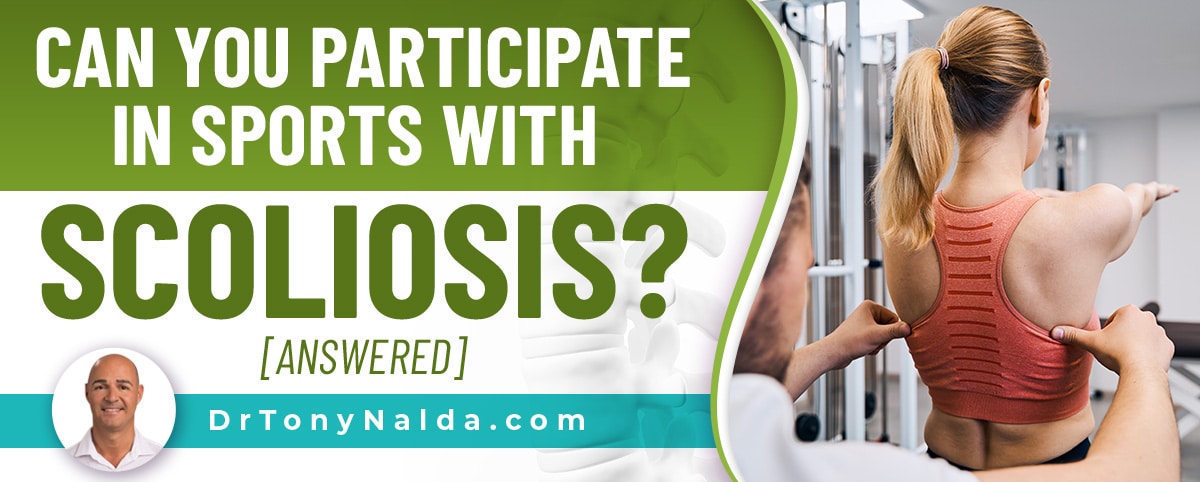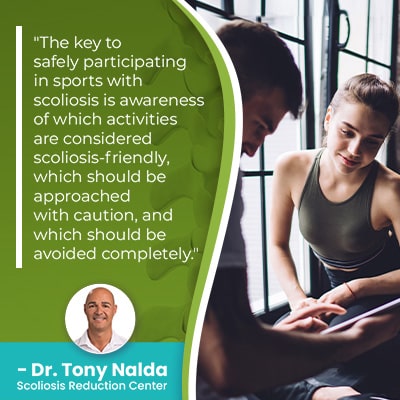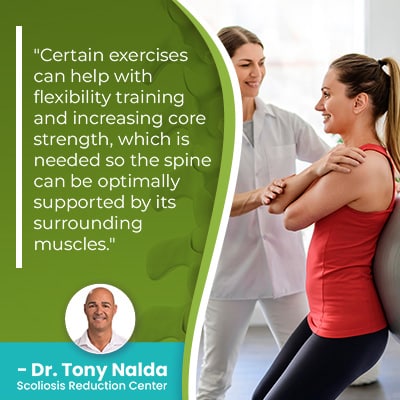Can You Participate In Sports With Scoliosis? [ANSWERED]

No type of sport or exercise should be attempted before it's been cleared with a patient's scoliosis treatment provider, but when approved and safe, sports participation can be a means of strengthening muscles, increasing spinal flexibility and range of motion, and improving mental health, particularly for young athletes/patients with scoliosis.
There was a time when the place of exercise in scoliosis treatment was questioned, but we have since learned that when combined with other types of proactive treatment like chiropractic care and physical therapy, sports and exercise can help in a number of ways, as long as they are scoliosis-friendly.
Before specifically addressing whether or not scoliosis can keep you from playing sports, let's talk about what it can be like to live with scoliosis.
Table of Contents
Life with Scoliosis
In order to be diagnosed with scoliosis, a number of parameters have to be met, and this includes the development of an unnatural sideways spinal curve that also rotates and has a minimum Cobb angle of 10 degrees.
The fact that a scoliotic curve twists unnaturally, in addition to bending unnaturally, makes it a complex 3-dimensional condition, and effective treatment has to address it as such.
Cobb angle is a measurement obtained during X-ray that involves drawing lines from the tops and bottoms of the curve's most-tilted vertebrae, and the resulting angle is expressed in degrees.
A patient's Cobb angle is important because it tells me how far out of alignment the patient's spine is, and also classifies conditions based on severity:
- Mild scoliosis: Cobb angle measurement of between 10 and 25 degrees
- Moderate scoliosis: Cobb angle measurement of between 25 and 40 degrees
- Severe scoliosis: Cobb angle measurement of 40+ degrees
- Very-severe scoliosis: Cobb angle measurement of 80+ degrees
Being diagnosed with scoliosis also means being diagnosed with a progressive condition whose nature is to get worse over time, so where a scoliosis is at the time of diagnosis isn't always indicative of where it will stay.
The more severe a condition, the more likely it is that its effects are going to be noticeable, so let's move on to the condition's common symptoms, for a better general understanding of how scoliosis affects the body.
How Scoliosis Affects the Body
Scoliosis introduces a lot of uneven forces to the body, and those forces can disrupt the body's overall health and symmetry.
When scoliosis is mild, its effects are mild, and it's rare to have functional deficits at this early stage in the condition's progressive line.
There are also different types of scoliosis that can affect the body differently, but the most-prevalent form is adolescent idiopathic scoliosis, diagnosed between the ages of 10 and 18, so we'll focus on this type for our current purposes.
In adolescents, the condition's main effect is postural deviation:
- Uneven shoulders
- Uneven shoulder blades
- Uneven hips
- The development of a rib arch
- Uneven waist line
- Arms and legs that appear to hang at different lengths
Additional effects of scoliosis can include changes to balance, coordination, gait, and clothing that suddenly seems ill-fitting.
In adults, the condition's main effect is pain, and that's because scoliosis becomes a compressive condition once skeletal maturity has been reached.
It's the uneven forces of the condition that introduce adverse spinal tension and compression, and this is why sports participation, while indeed possible, needs to be approached with caution.
What Sports are Safe for Scoliosis?
People might think that having an unnaturally-curved spine means a life of limitations and inactivity, but it doesn't have to be that way; in fact, many celebrities and professional athletes continue to thrive, despite being diagnosed with scoliosis.
It can be particularly beneficial for scoliosis patients to practice a healthy active lifestyle, and sports participation and exercise can be a big part of that.
 The key to safely participating in sports with scoliosis is awareness of which activities are considered scoliosis-friendly, which should be approached with caution, and which should be avoided completely.
The key to safely participating in sports with scoliosis is awareness of which activities are considered scoliosis-friendly, which should be approached with caution, and which should be avoided completely.
Scoliosis-friendly sports and exercise are those that facilitate a strong and balanced spine, provide a great cardiovascular workout, increase the strength of core muscles so the spine can be optimally supported, help with flexibility training, muscle weakness, and don't put the spine in unnatural positions that increase tension and compression.
Because each case of scoliosis is unique, it can be difficult to say which sports are safe because different severity levels, angles of rotation, patient age, and a number of other factors can affect a patient's treatment, and whether or not activity restrictions are in place.
Once approved by a patient's treatment provider, in general, the following sports are seen as safe for scoliosis:
- Practicing yoga (scoliosis-specific yoga with modified poses)
- Walking (works muscles symmetrically)
- Swimming (gravity-free environment means taking pressure off the spine)
- Road cycling (limit off road cycling)
- Cross country skiing (symmetrical motion)
- Strength training (can help increase core muscles)
- Stretching (regular stretching relieves tension and prevents stiffness)
- Soccer
The aforementioned exercises and sports are generally considered safe for scoliosis patients because they work the body's muscles symmetrically, don't introduce spinal compression or adverse spinal tension, and don't aggravate scoliosis or involve hyperextending the spine.
There is, also, the mental-health benefit of participating in sports and how it boosts self esteem, particularly when it comes to active adolescent idiopathic scoliosis patients.
Which Sports are Not Safe for Scoliosis?
Now, when it comes to certain sports to avoid with scoliosis, these tend to include any that involve downward landing force stresses, repeated shocks from impact, introduce significant stress, severely rotate the spine, overuse one side of the body's muscles, and place undue stress on the spine.
Again, each case is unique, but common sports considered unsafe for scoliosis can include:
- Weight lifting (certain types of deadlifts)
- Rhythmic gymnastics (involves hyperextending the spine)
- Diving (hyperextending the spine)
- Golf (overuses one side of the body's muscles)
- Tennis (overuses one side of the body's muscles)
- Bowling (overuses one side of the body's muscles)
- Horseback riding (repeated shock from downward landing force stresses)
- Collision sports (hockey, football, wrestling)
 Certain exercises can help with flexibility training and increasing core strength, which is needed so the spine can be optimally supported by its surrounding muscles.
Certain exercises can help with flexibility training and increasing core strength, which is needed so the spine can be optimally supported by its surrounding muscles.
One of the condition's effects can be a muscle imbalance, so sports and exercises that overuse one side of the body can exacerbate the condition's asymmetrical effects; a muscle imbalance can develop as the unnatural spinal curve pulls the spine's surrounding muscles in different directions.
Muscles on one side of the spine can become weak from underuse, while muscles on the other side can become loose and stretched from overuse.
When crafted by a spine specialist, certain sports and scoliosis-specific exercises can help restore muscle balance by creating stronger muscles, restore range of motion in the spine, making it more responsive to treatment, can keep the body nimble, making it more responsive to treatment, and improve the spine's posture.
Conclusion
When it comes to designing a potentially successful treatment plan, as a supporter of a modern conservative treatment approach, exercise and physical activity will always be part of the plan.
Here at the Scoliosis Reduction Center, certain exercises are integrated into a scoliosis-specific treatment plan so they can help increase core strength, address any related muscle weakness and/or muscle imbalance, and help scoliosis curves stay as flexible as possible.
Physical activities that are known for aggravating scoliosis curves should be avoided not only because they aren't good for the scoliotic spine, but also because they can interfere with treatment, which is why, again, any sports, competitive sports, contact sports, low impact sport, have to first be approved by the scoliosis-treatment provider.
I encourage my patients with scoliosis to play sports, as long as it is safe for them to do so as strong core muscles encourage a natural curvature of the spine.
As a progressive condition, one of the main goals of treatment is to reduce spinal curves on a structural level and to stop scoliosis progression.
When spinal compression occurs in adult scoliosis, or because of an unsafe sport in adolescent idiopathic scoliosis patients, people with scoliosis are likely to experience back pain and pain that radiates into the body's extremities due to nerve compression.
Another goal of my conservative treatment approach at the Center is to help patients avoid the need for invasive spine surgery in the future.
There was a time when a scoliosis diagnosis seemed like a sentence, but we have since learned that having scoliosis neither has to define a person, nor does it mean they can't participate in sports; it means that certain sports and exercises should be approached with caution, and others avoided.
If you are unsure of what exercises and/or sports you should be participating in, don't hesitate to reach out for guidance and support; we can answer all your condition-related questions and more.
Dr. Tony Nalda
DOCTOR OF CHIROPRACTIC
After receiving an undergraduate degree in psychology and his Doctorate of Chiropractic from Life University, Dr. Nalda settled in Celebration, Florida and proceeded to build one of Central Florida’s most successful chiropractic clinics.
His experience with patients suffering from scoliosis, and the confusion and frustration they faced, led him to seek a specialty in scoliosis care. In 2006 he completed his Intensive Care Certification from CLEAR Institute, a leading scoliosis educational and certification center.
About Dr. Tony Nalda
 Ready to explore scoliosis treatment? Contact Us Now
Ready to explore scoliosis treatment? Contact Us Now





